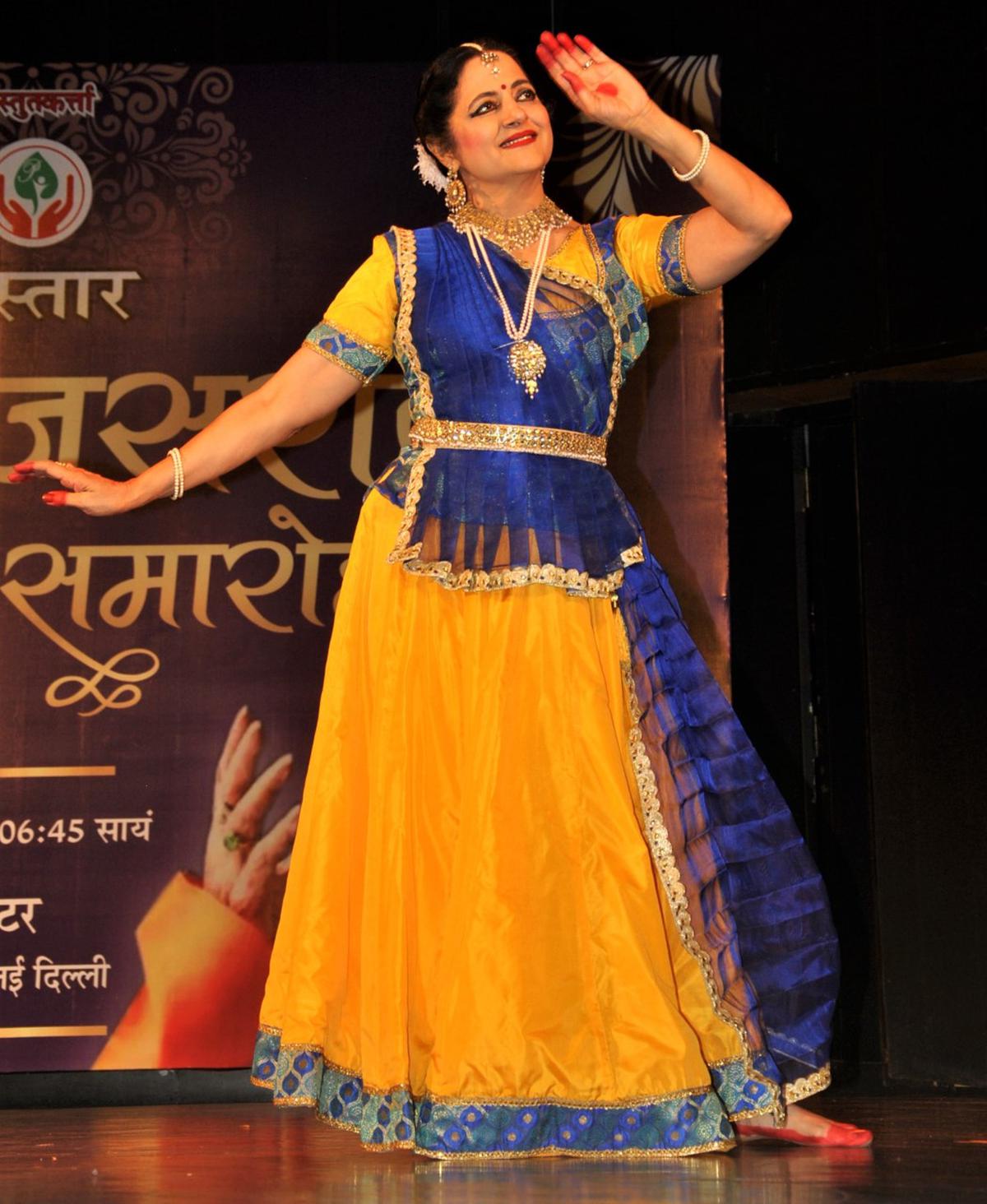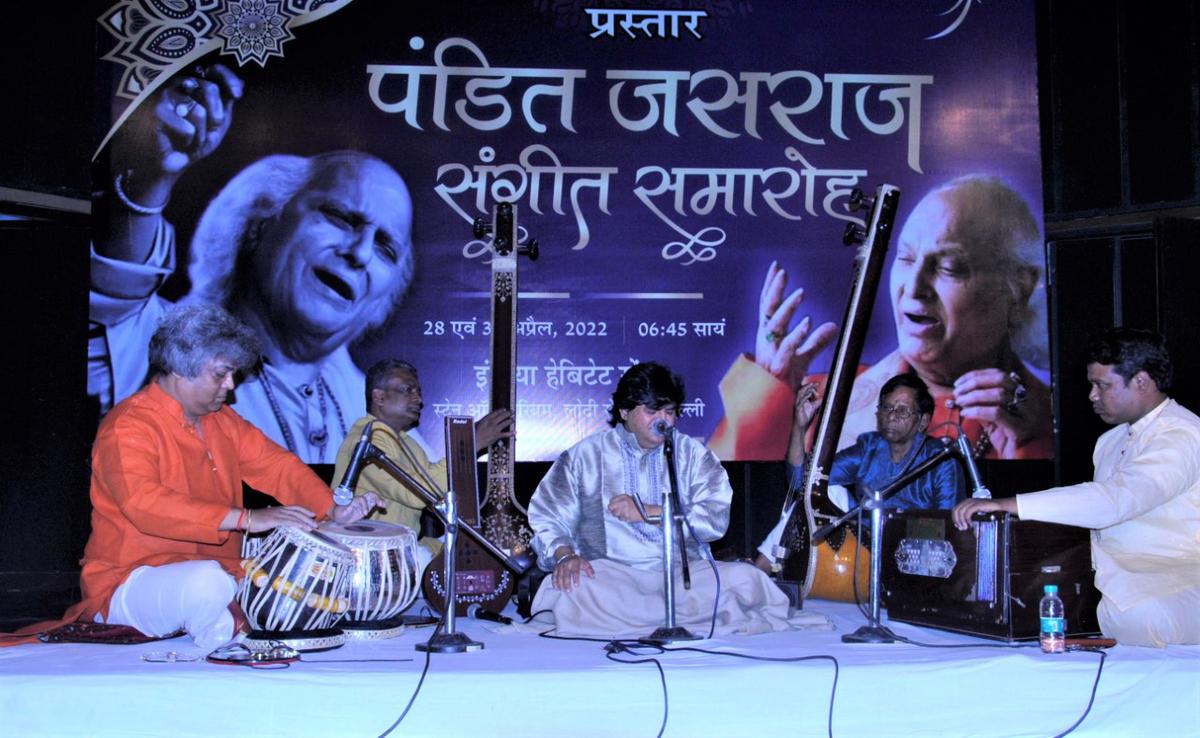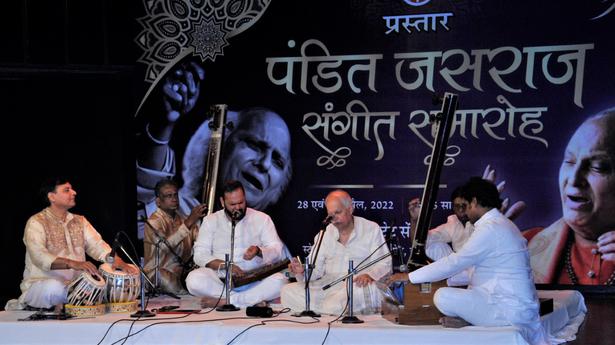The two-day Pt. Jasraj Sangeet Samaroh was a celebration of rhythm and melody
The two-day Pt. Jasraj Sangeet Samaroh was a celebration of rhythm and melody
Pt. Jasraj Sangeet Samaroh is an annual event presented by Prastaar. Founded by eminent shehnai artiste Lokesh Anand, the festival is an ode to his guru, Pt. Jasraj. Initiated by his father into the basic techniques of shehnai playing, Lokesh trained under Pt. Anant Lal and Pt. Daya Shankar before Pt. Jasraj took him under his wings. Lokesh learnt almost all of the compositions of the Mewati Gharana, and often accompanied Pt. Jasraj on the shehnai at his concerts.
The two-day sangeet samaroh showcased art in its entirety as defined by Sharngadeva in his Sangeet Ratnakar, ‘Geetam vaadyam tathaa nrityam/trayam sangeetam uchchyate’. It was held at the Stein auditorium, New Delhi.
Significant phrases
Pt. Sajan Mishra with his son and disciple Swaransh Mishra.
| Photo Credit: Special Arrangement
The inaugural evening reached its climax with the reposeful rendering of raag Jhinjhoti by Pt. Sajan Mishra with vocal support from his son and disciple, Swaransh Mishra. The introductory auchar (aalap) of the raag created a divine aura for the neatly enunciated bandish, ‘Mahadeva Maheshwar’, set to slow Jhaptaal. Sung as a vilambit khayal, the traditional composition explored the attributes of Shiva through bol-aalap. The gradual vistar (exploration) with significant phrases of the raag etched its outline before taans adorned it aesthetically.
Ably accompanied on the tabla by Akram Khan of the Ajrada gharana and Sumit Mishra on the harmonium, the Mishras went ahead with the chhota khayal ‘Roko na gail Mohan mohe jane do’ in Teentaal, which had Shringar flavour, and sounded like a ‘Bandishi Thumri’. Flourishes of sargam and aakar taans and rhythmic tihais with hide and seek like ‘ched-chhad’ (playfulness) with the bols of the bandish brought back memories of late Rajan Mishra. The two brothers had an uncanny ability to pre-empt each other’s moves, contrasting soft and vibrant stretches. Swaransh did his best to make Pt. Sajan Mishra feel comfortable. The concluding Bhairavi, ‘Dhanya bhaag seva ka avsar paaya’ sounded most appropriate because the senior vocalist had introduced the composition as a haaziri (ode) to Pt. Jasraj.

Neelima Bery.
| Photo Credit: Special Arrangement
Neelima Bery, the graceful Kathak dancer of Lucknow Gharana, gave a brilliant start to the festival . Trained under Pt. Birju Maharaj and Munna Shukla, Neelima opened with Krishna vandana, ‘Barnat chhavi Shyam-Sundar’, written and composed by Pt. Birju Maharaj. She went on to present the nritta segment set to 14 beats cycle of the challenging Dhamar taal with thaat, amad tode-tukde, paran, and more.
The same 14 beats were converted into a different chhand when she danced to the tarana in Drut Ada Chautaal, interspersed with bandishes and lehera in Dhamar. This proved her command over laya and taal, while her abhinaya prowess came to the fore in a Jhoola composition, ‘Jhoolan kamuna koolan’, set to Drut Ektaal in raag Malkauns. Neelima next demonstrated crisp footwork, preceded by a ‘Dhittam dhittam dagdag thun tak thun’ with the lehera, the musical refrain, shifting to raag Bhairavi, concluding with 25 chakkars (pirouettes) that left the audience enthralled.
Elaborate raag treatise

Rattan Mohan Sharma.
| Photo Credit: Special Arrangement
The second evening began with the vocal recital by Rattan Mohan Sharma, the nephew and foremost disciple of Pt. Jasraj, and the current torchbearer of the Mewati Gharana. He chose the sombre evening raag Puriya, and elaborated it at great length. His treatment revealed his good understanding of the raag while presenting the bada khayal ‘Phulan ke harwa’, set to Vilambit Ektaal, and the chhota khayal ‘Shyam Kunvar more ghar aaye’ in Teentaal, concluding with a Pada of Haveli Sangeet. The superb accompaniment by Pt. Ashish Sengupta on his broad-faced tabla that sounded like a pakhawaj, and the intuitive harmonium playing by Zakir Dhaulpuri enhanced the concert’s appeal. No wonder Rattan Mohan Sharma forgot that a senior artiste was waiting to perform after him, leaving hardly any time for Pt. Nityanand Haldipur.

Pt. Nityanand Haldipur.
| Photo Credit: Special Arrangement
Totally devoid of artifice and gimmickry, the soulful flute recital by Pt. Nityanand Haldipur warmed the rasikas’ hearts from the very first note of Bihag. A senior disciple of the reclusive guru Annapurna Devi, Nityanand has inherited the essence of her music. Initiated into the art and aesthetics of flute by his father, Niranjan Haldipur, himself a disciple of the legendary Pt. Panna Lal Ghosh, Nityanand further trained under Chidanand Nagarkar and Pt. Devendra Murdeshwar. Such diverse training along with his own sensitivity has enriched the tonal quality of his music, making it deep, dignified and mature.
Accompanied on the tabla by Shailendra Mishra, Pt. Nityanand opened raag Bihag in gayaki ang with a Bada Khayal, set to Vilambit Ektaal, with controlled skill and immense musicality. The medium tempo bandish in Teentaal was so intricate and dicey that it misled Shailendra a bit, before the theka was indicated to him by the flautist. The melodious Dhun in Gara brought the Benarasi flavour of Shailendra’s tabla during the concluding laggi. Pt. Nityanand Haldipur’s performance provided a fitting finale to the Pt. Jasraj Sangeet Samaroh.
The Delhi-based writer specialises in classical arts.




